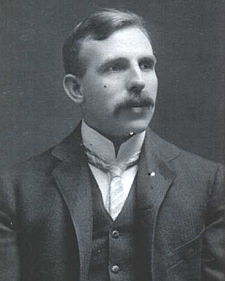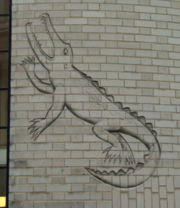Ernest Rutherford
2008/9 Schools Wikipedia Selection. Related subjects: British History 1750-1900; Chemists; Engineers and inventors
| Ernest Rutherford | |
 Ernest Rutherford, 1st Baron Rutherford of Nelson
|
|
| Born | August 30, 1871 Brightwater, New Zealand |
|---|---|
| Died | October 19, 1937 (aged 66) Cambridge, England |
| Residence | England |
| Nationality | New Zealand |
| Fields | Physicist |
| Institutions | McGill University University of Manchester |
| Alma mater | University of Canterbury Cambridge University |
| Doctoral advisor | J. J. Thomson Image:Nobel Prize.png |
| Doctoral students | Mark Oliphant Patrick Blackett Image:Nobel Prize.png Hans Geiger Niels Bohr Image:Nobel Prize.png Cecil Powell Image:Nobel Prize.png Teddy Bullard Pyotr Kapitsa Image:Nobel Prize.png John Cockcroft Image:Nobel Prize.png Ernest Walton Image:Nobel Prize.png Charles Drummond Ellis James Chadwick Image:Nobel Prize.png Ernest Marsden Edward Andrade Frederick Soddy Image:Nobel Prize.png Edward Victor Appleton Image:Nobel Prize.png Bertram Boltwood Kazimierz Fajans Charles Galton Darwin |
| Known for | Being "the father" of nuclear physics |
| Notable awards | Image:Nobel Prize.png Nobel Prize in Chemistry 1908 |
|
Notes
Note that he is the father-in-law of Ralph Fowler. Rutherford had a DSc (1900) from the University of New Zealand. |
|
Ernest Rutherford, 1st Baron Rutherford of Nelson OM PC FRS ( 30 August 1871 – 19 October 1937), widely referred to as Lord Rutherford, was a chemist (B.Sc. in chemistry and geology 1894, Canterbury College, New Zealand) and a physicist who became known as the "father" of nuclear physics. He pioneered the orbital theory of the atom through his discovery of Rutherford scattering off the nucleus with his gold foil experiment. He was awarded the Nobel Prize in Chemistry in 1908.
Early years
Ernest Rutherford was the son of James Rutherford, a farmer who had emigrated from Perth, Scotland, and his wife Martha (née Thompson), originally of Hornchurch, Essex, England. His parents had moved to New Zealand "to raise a little flax and a lot of children". Ernest was born at Spring Grove (now Brightwater), near Nelson, New Zealand. His name was mistakenly spelt Earnest Rutherford when his birth was registered. He studied at Havelock School and then Nelson College and won a scholarship to study at Canterbury College, University of New Zealand where he was president of the debating society among other things. In 1895, after gaining his BA, MA and BSc, and doing two years of research at the forefront of electrical technology, Rutherford travelled to England for postgraduate study at the Cavendish Laboratory, University of Cambridge (1895–1898), and he briefly held the world record for the distance over which electromagnetic waves could be detected. During the investigation of radioactivity he coined the terms alpha and beta to describe the two distinct types of radiation emitted by thorium and uranium.
Middle years
In 1898 Rutherford was appointed to the chair of physics at McGill University in Montreal, Canada, where he did the work which gained him the Nobel Prize in Chemistry 1908. From 1900 till 1903 he was joined by the young Frederick Soddy ( Nobel Prize in Chemistry 1921) where they collaborated on research into the transmutation of elements. Ernest Rutherford had demonstrated that radioactivity was the spontaneous disintegration of atoms. He noticed that a sample of radioactive material invariably took the same amount of time for half the sample to decay — its " half-life" — and created a practical application for this phenomenon using this constant rate of decay as a clock, which could then be used to help determine the actual age of the Earth that turned out to be much older than most scientists at the time believed.
In 1907 Rutherford took the chair of physics at the University of Manchester. There he did the experiments along with Hans Geiger and Ernest Marsden ( Geiger-Marsden experiment) that discovered the nuclear nature of atoms. It was his interpretation of this experiment that led him to the Rutherford model of the atom having a very small positively charged nucleus orbited by electrons. He became the first person in 1919 to transmute one element into another when he converted nitrogen into oxygen through the nuclear reaction 14N(α,p)17O. In 1921, while working with Niels Bohr (who postulated that electrons moved in specific orbits), Rutherford theorized about the existence of neutrons, which could somehow compensate for the repelling effect of the positive charges of protons by causing an attractive nuclear force and thus keeping the nuclei from breaking apart. Rutherford's theory of neutrons was later proved in 1932 by his associate James Chadwick who was awarded the Nobel Prize in Physics for his discovery in 1935.
Later years
He was knighted in 1914. In 1919 he returned to the Cavendish as Director. Under him, Nobel Prizes were awarded to Chadwick for discovering the neutron (in 1932), Cockcroft and Walton for splitting the atom using a particle accelerator and Appleton for demonstrating the existence of the ionosphere. He was admitted to the Order of Merit in 1925 and in 1931 was created Baron Rutherford of Nelson, of Cambridge in the County of Cambridge, a title which became extinct upon his unexpected death in hospital following a hernia operation. In 1900 he married Mary Georgina Newton (1876-1945); they had one daughter Eileen Mary (1901-1930), who married Ralph Fowler. He is interred in Westminster Abbey alongside J. J. Thomson.
Impact and legacy
His research, along with that of his protégé Sir Mark Oliphant, was instrumental in the convening of the Manhattan Project to develop the first nuclear weapons. He is famously quoted as saying: "In science there is only physics; all the rest is stamp collecting." He is also reputed to have stated that the idea of using nuclear reaction to generate useful power was "moonshine".
Things named after Rutherford include:
- the element rutherfordium, Rf, Z=104. (1997)
- craters on Mars and the Moon
- a building of the modern Cavendish Laboratory in the University of Cambridge, UK
- the Rutherford Institute for Innovation at the University of Cambridge, UK
- the physics and chemistry building at the University of Canterbury, New Zealand
- The Coupland Building where Rutherford worked at the University of Manchester was renamed "The Rutherford Building" in 2006
- The Ernest Rutherford Physics Building at McGill University, Montreal, Canada
- Rutherford College, a school in Auckland, New Zealand
- Rutherford Intermediate, Wanganui, New Zealand
- a house at his own high school, Nelson College,
- a house at Waimea College, Richmond, New Zealand
- a house at Corran School for Girls, Auckland, New Zealand
- a house at Rangiora High School, Rangiora, New Zealand
- a house at Macleans College, Auckland, New Zealand
- a house at Mount Roskill Grammar School, Auckland, New Zealand
- a house at Cashmere High School, Christchurch, New Zealand
- a house at Shirley Boys' High School, Christchurch, New Zealand
- a house at St Andrews College, Christchurch, New Zealand
- a house at Island School, Hong Kong
- a house at Tanjong Katong Secondary School, Singapore
- Rutherford College, a college at the University of Kent in Canterbury, UK
- a student hall at Loughborough University.
- a lecture theatre at the University of Manchester.
- Rutherford was the subject of a play by Stuart Hoar.
- Rochester and Rutherford Hall a boarding house at the University of Canterbury, Christchurch, New Zealand.
- Rutherford Appleton Laboratory a UK scientific research laboratory near Abingdon in Oxfordshire.
- Rutherford Close a residential street in Abingdon in Oxfordshire.
- a Physics classroom in the Portsmouth Grammar School
- Rutherford Road in biotech district of Carlsbad, CA, USA
- Lord Rutherford Road in Brightwater - his birthplace.
- Rutherford Street in Nelson.
- Rutherford Residence Hall at Fairleigh Dickinson University in Madison, NJ
On the side of the Mond Laboratory at the site of the original Cavendish Laboratory in Cambridge, there is an engraving in Rutherford's memory in the form of a crocodile, this being the nickname given to him by its commissioner, Rutherford's colleague Peter Kapitza. The initials of the engraver, Eric Gill, are visible within the mouth.
Rutherford's works
- Radio-activity (1904), 2nd ed. (1905), ISBN 978-1-60355-058-1
- Radioactive Transformations (1906), ISBN 978-160355-054-3
- Radiations from Radioactive Substances (1919)
- The Electrical Structure of Matter (1926)
- The Artificial Transmutation of the Elements (1933)
- The Newer Alchemy (1937)

